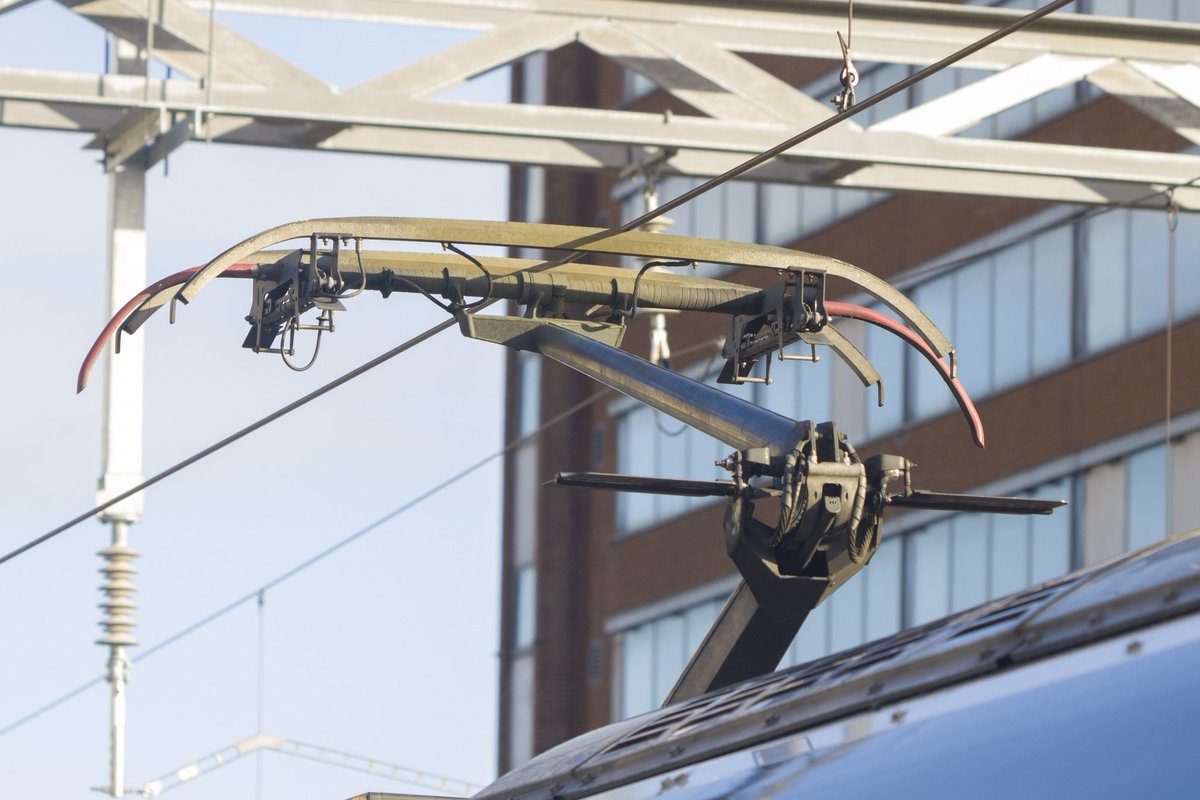Clamp, link, pulley: the 3 headspan genders (a #railwaysExplained thread)
A few of the #OLEbook images are a bit meh. So yesterday I went out on a trip to West Ealing to pick up some better ones. In this case, headspan supports.
But 1st, a refresher on along-track movement
1/


A few of the #OLEbook images are a bit meh. So yesterday I went out on a trip to West Ealing to pick up some better ones. In this case, headspan supports.
But 1st, a refresher on along-track movement
1/



All OLE systems have to deal with the phenomenon of along-track movement - the amount of expansion and contraction the wires experience as wire temperature varies, due to ambient heating/cooling from solar gain and wind, and also current heating due to electrical load
2/
2/

All modern mainline systems deal with this by using auto-tensioning; a device is provided at each end of the wire which provides a constant tension. Weights or springs are used, & the wires are able to expand / contract around a fixed central point - the midpoint anchor (MPA)
3/
3/
Obviously this movement must be allowed for in the design of the supports at each OLE structure. For a system using cantilever and/or portal structures, the MPA is simply a back-to-back catenary anchor, & along-track movement is dealt with by having pivoting cantilevers
4/

4/


But what about railways using headspans? These structures have no steel boom to fix an MPA to, or cantilevers that have a convenient place to insert a pivot.
Enter the clamp, link and pulley arrangements
5/
Enter the clamp, link and pulley arrangements
5/

First, lets deal with the MPA. This is essential to stop the wire run migrating along the track, and under a broken wire scenario the loads increase dramatically.
6/
6/
The flexible nature of the span wires means that no single headspan can resist the load from the MPA - especially under the broken wire scenario.
So instead the catenary wire is clamped to the headspan at 5 consecutive structures at the middle of the tension length
7/
So instead the catenary wire is clamped to the headspan at 5 consecutive structures at the middle of the tension length
7/

Now that we've fixed the MPA, the wires will expand and contract around it. But that means movement. The further you are from the midpoint, the more movement.
So the next few structures either side of the clamped structures have links. These swing to allow a bit of movement.
8/
So the next few structures either side of the clamped structures have links. These swing to allow a bit of movement.
8/

As we move even further from the MPA, the movement is too much for a link - at the tensioner end movement can be up to 1.5 metres. So a pulley is provided instead.
9/
9/

These pulleys can cause problems; the bearings can seize, and the resulting sawing action will break the wire & bring the whole lot down. So in the picture above the catenary hangs below the pulley & a more robust stainless steel bridle supports the catenary over the pulley.
9/
9/
In modern systems we try to avoid using pulleys altogether - one of the reasons we tend not to use headspans. But sometimes even on portal systems, clearances are too tight for a cantilever. Modern pulleys are smaller, so rotation is greater & seizure less likely to occur
10/
10/

That concludes my TED talk I'll take questions now
ends/
ends/
postscript: another component that I have on my "must improve" list is a line guard. See this thing here? It's a line guard.
That's right, I did a 2 hour trip to West Ealing, didn't notice the lineguard till I got home, didn't get a proper img. Will have to go back!
That's right, I did a 2 hour trip to West Ealing, didn't notice the lineguard till I got home, didn't get a proper img. Will have to go back!

If you enjoyed this thread there are plenty more here btw:
https://twitter.com/25kV/status/1187822175010590721
• • •
Missing some Tweet in this thread? You can try to
force a refresh












